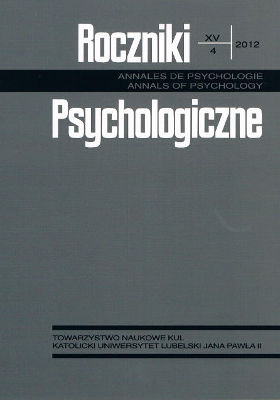Funkcjonowanie teorii umysłu u dzieci niewidomych
Abstrakt
Przedmiotem artykułu jest rozwój teorii umysłu u niewidomych dzieci. Badaniami objęto niewidome dzieci w wieku 7-14 lat. Wykonywały one cztery zadania. Dwa z nich: test zwodniczego pudełka oraz test niespodziewanej zmiany, pozwalały na ocenę rozumienia fałszywych przekonań, a dwa kolejne – umiejętności przyjmowania perspektywy innej osoby w odniesieniu do obiektów znanych i nieznanych. Stwierdzono, iż starsi uczniowie rozumieją fałszywe przekonania i potrafią przyjmować perspektywę innych osób w odniesieniu do obiektów znanych lepiej niż uczniowie młodsi. Ponadto zaobserwowano, iż niewidomym dzieciom mniej problemów sprawia rozumienie przekonań innych osób niż rozumienie perspektywy innej osoby, ale jedynie w sytuacji, gdy rozumienie perspektywy dotyczy obiektu nieznanego i abstrakcyjnego.
Bibliografia
Białecka-Pikul, M. (2002). Co dzieci wiedzą o umyśle i myśleniu. Badania i opis dziecięcej reprezentacji stanów mentalnych. Kraków: Wydawnictwo Uniwersytetu Jagiellońskiego.
Białecka-Pikul, M. (2004). Nabywanie wiedzy społecznej z perspektywy badań nad dziecięcymi teoriami umysłu. Przegląd Psychologiczny, 47, 3, 305-317.
Bigelow, A. (1988). Blind children’s concepts of how people see. Journal of Visual Impairment & Blindness, 82, 2, 65-68.
Bishop, M., Hobson, R. P., Lee, A. (2005). Symbolic play in congenitally blind children. Development and Psychopathology, 17, 2, 447-465.
Brambring, M. (2005). Perceptual perspective taking in children who are blind: The state of research and a single-case study. British Journal of Visual Impairment, 23, 3, 122-127.
Chlewiński, Z. (1999). Umysł. Dynamiczna organizacja pojęć. Analiza psychologiczna. Warszawa: Wydawnictwo Naukowe PWN.
Doherty, M. J. (2009). Theory of mind. How children undestand others’ thoughts and feelings. Hove–New York: Psychology Press.
Farrenkopf, C., Davidson, I. F. (1992). The development of perspective-taking abilities in young blind children. RE:view, 24, 1, 7-22.
Ferguson, R., Buultjens, M. (1995). The play behaviour of young blind children and its relationship to developmental stages. British Journal of Visual Impairment, 13, 3, 100-107.
Flavell, J. H., Everett, B. A., Croft, K., Flavell, E. R. (1981). Young children’s knowledge about perception: Further evidence for the Level 1 – Level 2 distinction. Developmental Psychology, 17, 1, 99-103.
Flavell, J. H., Miller, P. H., Miller, S. A. (1993). Cognitive development. Englewood Cliffs, NJ: Prentice Hall, Inc.
Green, S., Pring, L., Swettenham, J. (2004). An investigation of first-order false belief understanding of children with congenital profound visual impairment. British Journal of Developmental Psychology, 22, 1, 1-17.
Kielar-Turska, M. (2000). Rozwój człowieka w pełnym cyklu życia. W: J. Strelau (red.), Psychologia. Podręcznik akademicki, t. 1: Podstawy psychologii (s. 285-332). Gdańsk: GWP.
Kołodziejczyk, A. (2003). Dziecięca koncepcja fikcji, czyli co jest „na niby” w telewizji. Kraków: Wydawnictwo Uniwersytetu Jagiellońskiego.
McAlpine, L. M., Moore, C. L. (1995). The development of social understanding in children with visual impairments. Journal of Visual Impairment and Blindness, 89, 4, 349-358.
Miletic, G. (1994). Vibrotactile perception: Perspective taking by children who are visually impaired. Journal of Visual Impairment & Blindness, 88, 6, 550-563.
Miletic, G. (1995). Perspective taking: Knowledge of Level 1 and Level 2 rules by congenitally blind, low vision, and sighted children. Journal of Visual Impairment & Blindness, 89, 6, 514-523.
Minter, M., Hobson, R. P., Bishop, M. (1998). Congenital visual impairment and “theory of mind”. British Journal of Developmental Psychology, 16, 2, 183-196.
Peterson, C. C., Peterson, J. L., Webb, J. (2000). Factors influencing the development of a theory of mind in blind children. British Journal of Developmental Psychology, 18, 3, 431-447.
Premack, D., Woodruff, G. (1978). Does the chimpanzee have a theory of mind? Behavioral and Brain Sciences, 1, 515-526.
Roch-Levecq, A.-C. (2006). Production of basic emotions by children with congenital blindness: Evidence for the embodiment of theory of mind. British Journal of Developmental Psychology, 24, 3, 507-528.
Szubielska, M. (2010). Zdolności wyobrażeniowe niewidomych dzieci w zakresie skaningu i rotacji kształtu dotykanych obiektów. Roczniki Psychologiczne, 13, 2, 145-160.
Warren, D. H. (1994). Blindness and children. An individual differences approach. Cambridge: Cambridge University Press.
Watemberg, J., Cermak, S., Henderson, A. (1986). Right-left discrimination in blind and sighted children. Physical & Occupational Therapy in Pediatrics, 6, 1, 7-19.
Wimmer, H., Perner, J. (1983). Beliefs about beliefs: Representation and constraining function of wrong beliefs in young children’s understanding of deception. Cognition, 13, 103-128.
Copyright (c) 2012 Roczniki Psychologiczne

Utwór dostępny jest na licencji Creative Commons Uznanie autorstwa – Użycie niekomercyjne – Bez utworów zależnych 4.0 Międzynarodowe.


